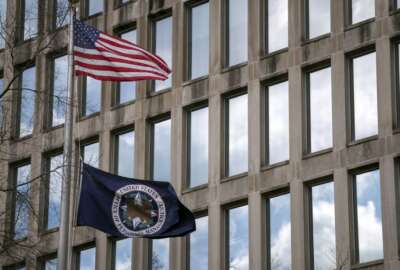Hubbard Radio Washington DC, LLC. All rights reserved. This website is not intended for users located within the European Economic Area.
On Air: Federal News Network
Trending:
2014 Federal Employee Viewpoint Survey: Senior leaders get low marks
Federal employees' opinions of senior leaders are at a five-year low, based on the Office of Personnel Management's survey of nearly 400,000 employees across go...
Federal employees’ opinions of senior leaders are at a five-year low, according to the 2014 Federal Employee Viewpoint Survey. More broadly, the survey of nearly 400,000 federal workers suggests they are more dissatisfied with their jobs than they were last year, when the Office of Personnel Management warned agencies to be concerned about low morale.
“While leaders across the government would like to see these scores go up, we have to remember that this has been a very difficult time for federal employees,” said Katherine Archuleta, director of OPM. “It’s going to take time for them to recover from an extended period of sequestration, furloughs and a government shutdown.”
The survey, administered by OPM, queries employees on all aspects of their work lives, including the work itself, their colleagues, immediate supervisors and leaders. The governmentwide numbers show positive responses to 32 of 77 questions fell over the past year, most by a percentage point. Questions that probed employees’ attitudes toward senior leaders dipped as much as 4 percent.
The contrast surprised experts who reviewed the results for Federal News Radio.
“If I was in the federal government, I’d be very troubled by this,” said John Salamone, a former OPM official who is now with Federal Management Partners.
The results underscore a communication problem between senior leaders and employees, he said, although it is not clear which senior leaders because OPM does not define the term in the survey.
When asked whether senior leaders in their organization maintain high standards of honesty and integrity, slightly more than half of the respondents said they either disagreed or were neutral. Just 49.5 percent agreed with that statement, down from 53.6 percent last year, and 57 percent in 2011.
“The positives are going down and the negatives are going up. It’s not like people are shifting into neutral,” said Jeff Neal, a former chief human capital officer of the Homeland Security Department and now with ICF International.
“It’s hard to maintain your relationship with an agency, your interest in the agency and your willingness to go above and beyond the call of duty for the agency if you don’t think your senior leaders are trustworthy and have integrity,” he said. “I’m not saying it’s true, but if it’s what somebody believes, it will drive their behavior. It may drive their productivity. It may drive their interest in remaining in the federal workforce and certainly in their agency.”
Dissatisfaction at larger agencies have pulled down the governmentwide averages. More than 10 percent of employees who filled out the survey work at the Homeland Security Department, which had the lowest engagement score, according to OPM’s analysis of the data. Indeed, barely a quarter of DHS employees who responded to the survey said their senior leaders generated high levels of motivation and commitment in the workforce.
DHS has grappled for years with low morale. It’s also suffered from high turnover, particularly in senior offices, and embarrassment related to employees’ abuse of overtime pay. Even scandals confined to one part of an agency hurt morale throughout its workforce, said Kathryn Medina, who was executive director of the Chief Human Capital Officers Council at OPM until earlier this year.
“If [employees] are hearing from their colleagues, family and friends about how terrible their agency is, it has an effect,” she said. “It’s not just people who have been personally impacted.”
The governmentwide results also could reflect unease with a constant churn of political appointees, including deputy secretaries and undersecretaries, whose comings and goings do not receive much attention outside the office. Some vacancies have lingered for months, either because President Barack Obama has not nominated a replacement or the Senate has not confirmed them.
“Each of those scenarios can cause a whole set of unintended consequences in terms of productivity, morale, and perceptions of leadership and support,” said Medina, noting that she has seen a steady changeover from the 2012 presidential election until now.
Employees may think, “How does my agency support me? It hasn’t given me a new boss in the last six months,” she said. “Is it the agency’s fault? Probably not.”
Finally, she said, the declining opinions of senior leaders are a “hangover effect” that shows federal employees have yet to recover from the past several years of budget constraints and battles between the White House and Congress, culminating with the government shutdown in October 2013, just six months before the survey was administered.
Just because Congress avoided another shutdown this year by passing a continuing resolution does not mean the problems have gone away, she said.
The “silver lining”
In comparison to the sentiments about senior leaders, employees look more kindly upon themselves, their direct supervisors and their workmates. While positive responses to nearly two dozen questions about these topics dipped slightly, the change was not as dramatic as in recent years.
Federal employees continue to believe in their missions, and see themselves as resourceful and diligent. When asked whether the work they did was important, nearly 90 percent of respondents answered positively. When asked whether they were willing to put in the extra effort to get a job done, more than 95 percent of respondents answered positively. And when asked whether they were constantly looking for ways to do their jobs better, 90 percent answered positively.
That’s the silver lining in this report, said Salamone.
“Those are numbers the federal government can latch onto and use moving forward,” he said. “The energy of federal employees and the excitement they have for their jobs and their willingness to put in the extra effort are elements that, if I were working for an agency, I’d build a recruitment plan around.”
Another relative bright spot is the slight, but consistent uptick in employees’ opinions of their direct supervisors. Responses to questions about immediate supervisors also changed little from last year. Nearly three-quarters of respondents said their supervisor listens to them and 80 percent said their supervisor treats them with respect.
“People tend to like first-level supervisors better than they do senior leaders of agencies, in part because those are the people they work with all the time,” said Neal.
A question about salary (“Considering everything, how satisfied are you with your pay?”) had the biggest bump in positive responses. Fifty-six percent of people said they were satisfied, an increase of more than 2 percent over last year.
After three years of a pay freeze, this year’s 1 percent pay raise “is enough to not be poking them collectively in the eye,” Neal said.
On the other hand, just a fifth of employees say pay raises depend on how well they do their jobs.
The devil is in the agencies’ detailed reports
While the governmentwide numbers reflect a trend, it’s the agencies’ individual results that reveal the underlying story.
For the first time, OPM has given agencies office- by-office comparisons. It has including results for any office where at least 10 employees completed the survey.
“Agencies asked for breakdowns so they could be granular about where their trouble spots are. They didn’t want to see them from 50,000 feet, but by unit and subunit and pinpoint where they had problems,” said Medina, who participated in planning discussions for this year’s survey.
But agencies must do more to understand which senior leaders employees are referring to and why, Salamone said. The term is so vague that the Senior Executives Association, which represents Senior Executive Service members, has cautioned agencies not to draw conclusions about particular officials based on the survey results. It is asking OPM to define the term in future surveys. For this year, Salamone said, agencies should hold focus groups with employees to understand the issues.
“If they get a good handle on the leadership aspects, it will go a long way to drive the rest of the numbers up,” he said. “As the leadership of an organization goes, the rest of the organization will follow.”
But problems with senior leadership are not easily or quickly resolved. In response to persistent morale problems, DHS has created training programs for senior-level executives, Neal said. But, he cautioned, the results won’t be immediately apparent.
“You don’t dip a manager into a magic bath and they go from not being so hot to being great in a few weeks or months. It takes time to build the programs and have people go through those programs,” he said. “We’re not going to have any miracle cures that fix things right away.”
The 2014 survey is proof of that.
RELATED STORIES:
Four EVS data trends: When you’re up, you’re up
Federal Employee Viewpoint Survey: The price of mistrust
Latest employee viewpoint survey shows dissatisfaction with VA’s senior leaders
Employee Viewpoint Survey reveals warts and all to federal managers
Copyright © 2024 Federal News Network. All rights reserved. This website is not intended for users located within the European Economic Area.




